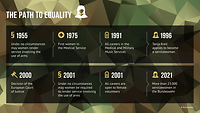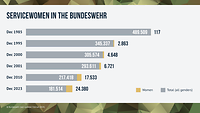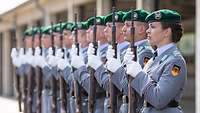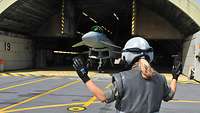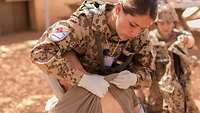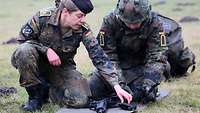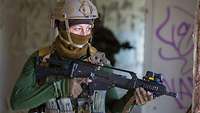Women in the Bundeswehr
They fly combat aircraft and helicopters. They jump out of planes and drive tanks. They command naval ships and line companies. Today, it is hard to imagine the Bundeswehr without women. Servicewomen have now made their way into almost every area of what was once a man’s world.
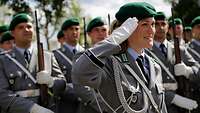
Women in the Bundeswehr: made possible by Europe
Until 2001, it seemed impossible. While women were allowed to enlist as volunteers in the Military Music Service or the Medical Service, they were prohibited from serving in combat forces. Only in 2000 did a decision by the European Court of Justice grant them unrestricted access to all military careers. There are now more than 24,000 female soldiers serving in the Bundeswehr – and that number is growing. Women now account for about thirteen percent of the Bundeswehr’s some 182,000 military personnel.
What matters is performance
The Bundeswehr offers women a wide variety of career options. They serve on equal footing with their male counterparts as boat or tank commanders, as doctors or ITInformationstechnik specialists, both in Germany and on the Bundeswehr’s operations and standby commitments. From marksmanship and marching to leadership – servicewomen have to achieve the same level of performance as servicemen. The Bundeswehr only differentiates between men and women when evaluating athletic performance.
Civilian women in the Bundeswehr
The Bundeswehr offers women not only the opportunity to advance within the forces from nonrated personnel to the highest general ranks, but also many career prospects and opportunities for advancement in the civilian sector of the Bundeswehr. More than 80,000 civilian employees work for the Bundeswehr. Over 31,000 or around 39 percent are female. Female employees and civil servants in the Bundeswehr work as administrative specialists in various parts of the armed forces or the defence administration, as well as engineers for defence technology or biologists and geologists. Today, women are also in charge of the executive levels of defence administration offices and entire major organisational elements.
What civilian status do women employed in the Bundeswehr have?
| Total number of civil servants | 10.635 |
| In higher service | 2.195 |
| In higher intermediate service | 4.457 |
| In intermediate service | 3.962 |
| In ordinary service | 21 |
| Employees | 19.152 |
| In preparatory service or trainees/interns | 1.928 |
Last updated: 30. April 2025
An increasing number of servicewomen
In 2001, there were more than 6,700 servicewomen in the Bundeswehr. Their number has continued to increase since then. Today, about one in five applications for voluntary military service and one in three for officer’s careers come from young women. This trend should continue. What matters is performance – not gender.
How many women serve in each area?
| Servicewomen per armed service/major organisational element | |
|---|---|
| Army | 4.843 |
| Air Force | 2.882 |
| Navy | 1.731 |
| Cyber and Information Domain Service | 1.440 |
| Joint Support and Enabling Service | 3.280 |
| Medical Service | 8.363 |
| Joint Support Service* | 95 |
| Federal Ministry of Defence and other areas | 2.213 |
*The Joint Support Service has been included in this list for the first time. However, this is not a precise representation of personnel levels yet.
What rank do the servicewomen have?
| Servicewomen by rank category (including candidates) | |
|---|---|
| Officers | 7.069 |
| Senior NCOs | 8.762 |
| Junior NCOs | 3.436 |
| Rank and file | 5.580 |
What status do the servicewomen have?
| Servicewomen by status | |
|---|---|
| Career service member | 5.515 |
| Temporary-career volunteer | 17.311 |
| Extended voluntary service conscripts | 2.008 |
| Extended voluntary service conscripts in Homeland Security | 13 |
All three tables last updated: 30. April 2025


